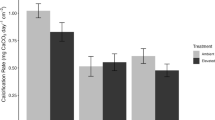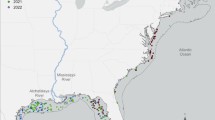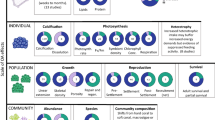Abstract
Carbonate removal using acids is a common practice in ecological studies. The effects, however, of acid pre-treatment on the elemental and isotopic composition of marine invertebrates as well as how these effects vary according to species’ carbonate content is little known. We examined the effects of acid pre-treatment on the elemental (%C, %N, C:N ratio (%C:%N)) and isotopic composition (δ13C, δ15N) of 28 lightly- and heavily-calcified species from Cnidaria, Mollusca, Arthropoda, Bryozoa, Echinodermata and Chordata. The present study showed that acid pre-treatment modified the elemental and isotopic composition of lightly- and heavily-calcified marine invertebrates. The shifts were clearly seen as a decrease in the %C and δ13C of heavily-calcified species while we did not detect a clear pattern for %N and δ15N (in both lightly- and heavily calcified species). Apart from carbonates, acid pre-treatment caused also the loss of organic compounds, thus confounding the interpretation of carbonate proxy (CP) -a widely used proxy for carbonate content. We recommend the use of CP solely with heavily-calcified species. For the first time it was shown that the use of δ15N values from acidified samples can introduce substantial bias in our perception about the number of trophic levels, the distribution of species and distribution of biomass across the trophic levels in a community. We have uncovered and elucidated previously unknown aspects and highlighted the challenge posed when predicting shifts in elemental and isotopic composition of species following acid pre-treatment. The present findings should be considered in future studies using acid pre-treatment as they can contribute to the optimum use of samples while avoiding bias in the interpretation of findings.
Article PDF
Similar content being viewed by others
Avoid common mistakes on your manuscript.
References
Bicknell AWJ, Campbell M, Knight ME, Bilton DT, Newton J, Votier SC (2011) Effects of formalin preservation on stable carbon and nitrogen isotope signatures in calanoid copepods: implications for the use of Continuous Plankton Recorder Survey samples in stable isotope analyses. Rapid Commun Mass Sp 25:1794–1800. doi:https://doi.org/10.1002/rcm.5049
Bosley KL, Wainright SC (1999) Effects of preservatives and acidification on the stable isotope ratios (15N:14N, 13C:12C) of two species of marine animals. Can J Fish Aquat Sci 56:2181–2185
Brodie CR, Leng MJ, Casford JSL, Kendrick CP, Lloyd JM, Yongqiang Z, Bird MI (2011) Evidence for bias in C and N concentrations and δ13C composition of terrestrial and aquatic organic materials due to pre-analysis acid preparation methods. Chem Geol 282:67–83. doi:https://doi.org/10.1016/j.chemgeo.2011.01.007
Bunn SE, Loneragan NR, Kempster MA (1995) Effects of acid washing on stable isotope ratios of C and N in penaeid shrimp and seagrass: implications for food web studies using multiple stable isotopes. Limnol Oceanogr 40:622–625. doi:https://doi.org/10.4319/lo.1995.40.3.0622
Cabana G, Rasmussen JB (1996) Comparison of aquatic food chains using nitrogen isotopes. P Natl A Sci USA 93:10844–10847
Carabel S, Godinez-Dominguez E, Verisimo P, Fernandez L, Freire J (2006) An assessment of sample processing methods for stable isotope analyses of marine food webs. J Exp Mar Biol Ecol 336:254–261. doi:https://doi.org/10.1016/j.jembe.2006.06.001
de Lecea AM, Cooper R, Omarjee A, Smit AJ (2011) The effects of preservation methods, dyes and acidification on the isotopic values (δ15N and δ13C) of two zooplankton species from the KwaZulu-Natal Bight, South Africa. Rapid Commun Mass Sp 25:1853–1861. doi:https://doi.org/10.1002/rcm.5051
DeNiro JM, Epstein S (1981) Influence of diet on the distribution of nitrogen isotopes in animals. Geochim Cosmochim Ac 45:341–351
Demopoulos AWJ, Fry B, Smith CR (2007) Food web structure in exotic and native mangroves: a Hawaii-Puerto Rico comparison. Oecologia 153:675–686. doi:https://doi.org/10.1007/s00442-007-0751-x
Divine LM, Iken K, Bluhm BA (2015) Regional benthic food web structure on the Alaska Beaufort Sea shelf. Mar Ecol-Prog Ser 531:15–32. doi:https://doi.org/10.3354/meps11340
Edwards MS, Turner TF, Sharp ZD (2002) Short and long-term effects of fixation and preservation on stable isotope values (δ13C, δ15N, δ34S) of fluid-preserved museum specimens. Copeia 4:1106–1112
Fanelli E, Cartes JE, papiol V, Rumolo P, Sprovieri M (2010) Effects of preservation on the δ13C and δ15N values of deep-sea macrofauna. J Exp Mar Biol Ecol 395:93–97. doi:https://doi.org/10.1016/j.jembe.2010.08.020
Fantle MS, Dittel AI, Schwalm SM, Epifanio CE, Fogel ML (1999) A food web analysis of the juvenile blue crab, Callinectes sapidus, using stable isotopes in whole animals and individual amino acids. Oecologia 120:416–426. doi:https://doi.org/10.1007/s004420050874
Feder HM, Iken K, Blanchard AL, Jewett SC, Schonberg S (2011) Benthic food web structure in the southeastern Chukchi Sea: an assessment using δ13C and δ15N analyses. Polar Biol 34:521–532. doi:https://doi.org/10.1007/s00300-010-0906-9
Frost PC, Evans-White A, Finkel ZV, Jensen TC, Matzek V (2005) Are you what you eat? Physiological constraints on organismal stoichiometry in an elementally imbalanced world. Oikos 109:18–28. doi:https://doi.org/10.1111/j.0030-1299.2005.14049.x
Frost PC, Stelzer RS, Lamberti GA, Elser JJ (2002) Ecological stoichiometry of trophic interactions in the benthos: understanding the role of C:N:P ratios in Lentic and Lotic habitats. J N Am Benthol Soc 21:515–528
Goering J, Alexander V, Haubenstock N (1990) Seasonal variability of stable carbon and nitrogen isotope ratios of organisms in a North Pacific Bay. Estuar Coast Shelf S 30:239–260. doi:https://doi.org/10.1016/0272-7714(90)90050-2
Gontikaki E, Mayor DJ, Narayanaswamy BE, Witte UFM (2011) Feeding strategies of deep-sea sub-Arctic macrofauna of the Faroe-Shetland Channel: combining natural stable isotopes and enrichment techniques. Deep-Sea Res Pt I 58:160–172. doi:https://doi.org/10.1016/j.dsr.2010.11.011
González-Bergonzoni I, Vidal N, Wang B, Ning D, Liu Z, Jeppesen E, Meerhoff M (2015) General validation of formalin-preserved fish samples in food web studies using stable isotopes. Methods Ecol Evol 6:307–314. doi:https://doi.org/10.1111/2041-210X.12313
Grall J, Le Loc’h F, Guyonnet B, Riera P (2006) Community structure and food web based on stable isotopes (δ15N and δ13C) analysis of a North Eastern Atlantic maerl bed. J Exp Mar Biol Ecol 338:1–15. doi:https://doi.org/10.1016/j.jembe.2006.06.013
Hunter WR, Levin LA, Kitazato H, Witte U (2012) Macrobenthic assemblage structure and organismal stoichiometry control faunal processing of particulate organic carbon and nitrogen in oxygen minimum zone sediments. Biogeosciences 9:993–1006. doi:https://doi.org/10.5194/bg-9-993-2012
Iken K, Bluhm B, Dunton K (2010) Benthic food-web structure under differing water mass properties in the southern Chukchi Sea. Deep-Sea Res Pt II 57:71–85. doi:https://doi.org/10.1016/j.dsr2.2009.08.007
Jacob U, Mintenbeck K, Brey T, Knust R, Beyer K (2005) Stable isotope food web studies: a case for standardized sample treatment. Mar Ecol-Prog Ser 287:251–253
Jaschinski S, Hansen T, Sommer U (2008) Effects of acidification in multiple stable isotope analyses. Limnol Oceanogr-Meth 6:12–15. doi:https://doi.org/10.4319/lom.2008.6.12
Jeffreys RM, Burke C, Jamieson AJ, Narayanaswamy BE, Ruhl HA, Smith Jr KL, Witte U (2013) Feeding preferences of abyssal macrofauna inferred from in situ pulse chase experiments. PLoS One 8:e80510. doi:https://doi.org/10.1371/journal.pone.0080510
Kazanidis G, Henry L-A, Roberts JM, Witte UFM (2016) Biodiversity of Spongosorites coralliophaga (Stephens, 1915) on coral rubble at two contrasting cold-water coral reef settings. Coral Reefs 35:193–208. doi:https://doi.org/10.1007/s00338-015-1355-2
Kazanidis G, Witte UFM (2016) The trophic structure of Spongosorites coralliophaga-coral rubble communities at two northeast Atlantic cold water coral reefs. Mar Biol Res 12:932–947. doi:https://doi.org/10.1080/17451000.2016.1216569
King P, Kennedy H, Newton PP, Jickells TD, Brand T, Calvert S, Cauwet G, Etcheber H, Head B, Khripounoff A, Manighetti B, Miquel JC (1998) Analysis of total and organic carbon and total nitrogen in settling oceanic particles and a marine sediment: an interlaboratory comparison. Mar Chem 60:203–216. doi:https://doi.org/10.1016/S0304-4203(97)00106-0
Kolasinski J, Rogers K, Frouin P (2008) Effects of acidification on carbon and nitrogen stable isotopes of benthic macrofauna from a tropical coral reef. Rapid Commun Mass Sp 22:2955–2960. doi:https://doi.org/10.1002/rcm.3694
Lau DC, Leung KMY, Dudgeon D (2012) Preservation effects on C/N ratios and stable isotope signatures of freshwater fishes and benthic macroinvertebrates. Limnol Oceanogr-Meth 10:75–89. doi:https://doi.org/10.4319/lom.2012.10.75
Layman CA, Araujo MS, Boucek R, Hammerschlag-Peyer CM, Harrison E, Jud ZR, Matich P, Rosenblatt AE, Vaudo JJ, Yeager LA, Post DM, Bearhop S (2012) Applying stable isotopes to examine food-web structure: an overview of analytical tools. Biol Rev 87:545–562. doi:https://doi.org/10.1111/j.1469-185X.2011.00208.x
Liu B, Liu Y, Li Y, Wang H, Xu J (2013) An assessment of sample preservation methods for the determination of stable carbon and nitrogen isotope ratios in mollusks. Anal Lett 46:2620–2634. doi:https://doi.org/10.1080/00032719.2013.805415
Lohse L, Kloosterhuis RT, de Stigter HC, Helder W, van Raaphorst W, van Weering TCE (2000) Carbonate removal by acidification causes loss of nitrogenous compounds in continental margin sediments. Mar Chem 69:193–201. doi:https://doi.org/10.1016/S0304-4203(99)00105-X
Mateo MA, Serrano O, Serrano L, Michener RH (2008) Effects of sample preparation on stable isotope ratios of carbon and nitrogen in marine invertebrates: implications for food web studies using stable isotopes. Oecologia 157:105–115. doi:https://doi.org/10.1007/s00442-008-1052-8
Mazumder D, Iles J, Kelleway J, Kobayashi T, Knowles L, Saintilan N, Hollins S (2010) Effect of acidification on elemental and isotopic compositions of sediment organic matter and macroinvertebrate muscle tissues in food web research. Rapid Commun Mass Sp 24:2938–2942. doi:https://doi.org/10.1002/rcm.4729
McCutchan, JH, William ML, Kendall C, McGrath CC (2003) Variation in trophic shift for stable isotope ratios of carbon, nitrogen, and sulfur. Oikos 102:378–390. doi:https://doi.org/10.1034/j.1600-0706.2003.12098.x
Mill AC, Sweeting JC, Barnes C, Al-Habsi S, MacNeil AM (2008) Mass-spectrometer bias in stable isotope ecology. Limnol Oceanogr-Meth 6:34–39
Minagawa M, Wada E (1984) Stepwise enrichment of 15N along food chains: further evidence and the relations between δ15N and animal age. Geochim Cosmochim Ac 48:1135–1140. doi:https://doi.org/10.1016/0016-7037(84)90204-7
Mintenbeck K, Jacob U, Knust R, Arntz WE, Brey T (2007) Depth-dependence in stable isotope ratio δ15N of benthic POM consumers: the role of particle dynamics and organism trophic guild. Deep-Sea Res Pt I 54:1015–1023. doi:https://doi.org/10.1016/j.dsr.2007.03.005
Ng JSS, Wai T-C, Williams GA (2007) The effects of acidification on the stable isotope signatures of marine algae and molluscs. Mar Chem 103:97–102. doi:https://doi.org/10.1016/j.marchem.2006.09.001
Post DM (2002) Using stable isotopes to estimate trophic position: models, methods, and assumptions. Ecology 83:703–718. doi:https://doi.org/10.1890/0012-9658(2002)083[0703:USITET]2.0.CO;2
Rennie MD, Ozersky T, Evans DO (2012) Effects of formalin preservation on invertebrate stable isotope values over decadal time scales. Can J Zoolog 90:1320–1327. doi:https://doi.org/10.1139/z2012-101
Roberts JM, Shipboard Party (2013) Changing oceans expedition 2012. Heriot-Watt University, Edinburgh, RRS James Cook 073 Cruise Report, 224 p
Ruiz-Cooley RI, Garcia KY, Hetherington ED (2011) Effects of lipid removal and preservatives on carbon and nitrogen stable isotope ratios of squid tissues: implications for ecological studies. J Exp Mar Biol Ecol 407:101–107. doi:https://doi.org/10.1016/j.jembe.2011.07.002
Sarakinos HC, Johnson ML, Vander Zanden MJ (2002) A synthesis of tissue preservation effects on carbon and nitrogen stable isotope signatures. Can J Zoolog 80:381–387
Schlacher TA, Connolly RM (2014) Effects of acid treatment on carbon and nitrogen stable isotope ratios in ecological samples: a review and synthesis. Methods Ecol Evol 5:541–550. doi:https://doi.org/10.1111/2041-210X.12183
Serrano S, Serrano L, Mateo MA, Colombini I, Chelazzi L, Gagnarli E, Fallaci M (2008) Acid washing effect on elemental and isotopic composition of whole beach arthropods: Implications for food web studies using stable isotopes. Acta Oecol 34:89–96. doi:https://doi.org/10.1016/j.actao.2008.04.002
Sokolowski A, Szczepańska A, Richard P, Kędra M, Wolowicz M, Węslawski JM (2014) Trophic structure of the microbenthic community of Hornsund, Spitsbergen, based on the determination of stable carbon and nitrogen isotopic. Polar Biol 37:1247–1260. doi:https://doi.org/10.1007/s00300-014-1517-7
Søreide JE, Tamelander T, Hop H, Hobson KA, Johansen I (2006) Sample preparation effects on stable C and N isotope values: a comparison of methods in Arctic marine food web studies. Mar Ecol-Prog Ser 328:17–28. doi:https://doi.org/10.3354/meps328017
Sterner RW, Elser JJ (2002) Ecological stoichiometry. Princeton University Press, Princeton, 382 p
Sweetman AK, Witte U (2008) Response of an abyssal macrofaunal community to a phytodetrital pulse. Mar Ecol-Prog Ser 355:73–84. doi:https://doi.org/10.3354/meps07240
Syväranta J, Vesala S, Rask M, Ruuhijärvi J, Jones RI (2008) Evaluating the utility of stable isotope analyses of archived freshwater sample materials 600:121–130. doi:https://doi.org/10.1007/s10750-007-9181-3
Tu KL, Blanchard AL, Iken K, Horstmann-Dehn L (2015) Small-scale spatial variability in benthic food webs in the northeastern Chukchi Sea. Mar Ecol-Prog Ser 528:19–37. doi:10.3354meps11216
Vafeiadou A, Adao H, De Troch M, Moens T (2013) Sample acidification effects on carbon and nitrogen stable isotope ratios of macrofauna from a Zostera noltii bed. Mar Freshwater Res 64:741–745. doi:https://doi.org/10.1071/MF12169
van Oevelen D, Duineveld G, Lavaleye M, Mienis F, Soetaert K, Heip CHR (2009) The cold-water coral community as a hot spot for carbon cycling on continental margins: a food-web analysis from Rockall Bank (northeast Atlantic). Limnol Oceanogr 54:1829–1844. doi:https://doi.org/10.4319/lo.2009.54.6.1829
Vander Zanden MJ, Fetzer WW (2007) Global patterns of aquatic food chain length. Oikos 116:1378–1388. doi:https://doi.org/10.1111/j.0030-1299.2007.16036.x
Vander Zanden MJ, Rasmussen JB (1999) Primary consumer δ13C and ä15N and the trophic position of aquatic consumers. Ecology 80:1395–1404. doi:https://doi.org/10.1890/0012-9658(1999)080[1395:PCCANA]2.0.CO;2
Wolf N, Carleton SA, Martinez del Rio C (2009) Ten years of experimental animal isotopic ecology. Funct Ecol 23:17–26. doi:https://doi.org/10.1111/j.1365-2435.2009.01529.x
Xu J, Zhang M, Xie P (2011) Sympatric variability of isotopic baselines influences modeling of fish trophic patterns. Limnology 12:107–115. doi:https://doi.org/10.1007/s10201-010-0327-z
Yokoyama H, Sakami T, Ishihi Y (2009) Food sources of benthic animals on intertidal and subtidal bottoms in inner Ariake Sound, southern Japan, determined by stable isotopes. Estuar Coast Shelf S 82:243–253. doi:https://doi.org/10.1016/j.ecss.2009.01.010
Yokoyama H, Tamaki A, Harada K, Shimoda K, Koyama K, Ishihi Y (2005) Variability of diet-tissue isotopic fractionation in estuarine macrobenthos. Mar Ecol-Prog Ser 296:115–128. doi:https://doi.org/10.3354/meps29611
Acknowledgments
Special thanks to captains, crews and science parties of the RRS James Cook (JC073 Changing Oceans Expedition) and the CCGS Amundsen (2013 ArcticNet Expedition). Thanks also to the Holland-I ROV team (JC073 Changing Oceans Expedition). Thanks to Anni Makela (University of Aberdeen) and Cindy Grant (University of ISMER) for sampling of the megafauna. Also thanks to Dr Evina Gontikaki (University of Aberdeen) for her guidance on sample preparation for isotope analysis, Kenneth Cruickshank (University of Aberdeen) for analysis on sample elemental composition, Dr Joy Matthews, Sylvia Duncan and Emily Schick at UC Davis Stable Isotope Facility and Barry Thornton and Gillian Martin from the James Hutton Institute for their co-operation on sample stable isotope analysis. Funding for the JC073 cruise was provided by the Natural Environment Research Council (NERC) UK Ocean Acidification (UKOA) research programme’s Benthic Consortium project (NE/H017305/1 to J Murray Roberts). Funding for participation in the Arctic crusie with CCGS Amundsen was provided by NERC funded research project ArcDEEP (NE/J023094/1 to Ursula Witte). Funding for analytical costs and field work was provided by the Marine Alliance for Science and Technology for Scotland (MASTS) (Biodiversity Grant to Ursula Witte, 140 SF10003-10) and ArcDEEP (NERC grant NE/J023094/1). Georgios Kazanidis was funded by a MASTS PhD scholarship and S. Bourgeois by the NERC ArcDEEP project.
Author information
Authors and Affiliations
Corresponding author
Rights and permissions
Open Access This article is distributed under the terms of the Creative Commons Attribution 4.0 International License (http://creativecommons.org/licenses/by/4.0/), which permits unrestricted use, distribution, and reproduction in any medium, provided you give appropriate credit to the original author(s) and the source, provide a link to the Creative Commons license, and indicate if changes were made.
About this article
Cite this article
Kazanidis, G., Bourgeois, S. & Witte, U.F.M. On the Effects of Acid Pre-treatment on the Elemental and Isotopic Composition of Lightly- and Heavily-calcified Marine Invertebrates. Ocean Sci. J. 54, 257–270 (2019). https://doi.org/10.1007/s12601-019-0014-x
Received:
Revised:
Accepted:
Published:
Issue Date:
DOI: https://doi.org/10.1007/s12601-019-0014-x




